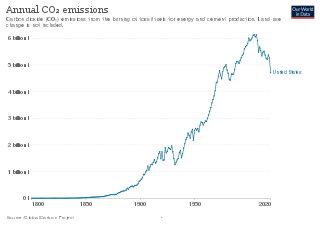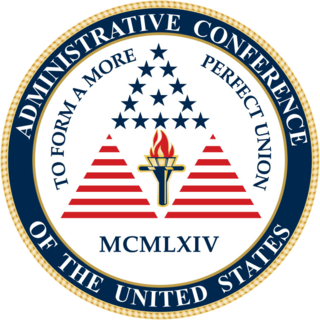In the United States government, independent agencies are agencies that exist outside the federal executive departments and the Executive Office of the President. In a narrower sense, the term refers only to those independent agencies that, while considered part of the executive branch, have regulatory or rulemaking authority and are insulated from presidential control, usually because the president's power to dismiss the agency head or a member is limited.

In the United States, an executive order is a directive by the president of the United States that manages operations of the federal government. The legal or constitutional basis for executive orders has multiple sources. Article Two of the United States Constitution gives presidents broad executive and enforcement authority to use their discretion to determine how to enforce the law or to otherwise manage the resources and staff of the executive branch. The ability to make such orders is also based on expressed or implied Acts of Congress that delegate to the president some degree of discretionary power. The vast majority of executive orders are proposed by federal agencies before being issued by the president.
In administrative law, rulemaking is the process that executive and independent agencies use to create, or promulgate, regulations. In general, legislatures first set broad policy mandates by passing statutes, then agencies create more detailed regulations through rulemaking.

The Office of Information and Regulatory Affairs is a Division within the Office of Management and Budget (OMB), which in turn, is within the Executive Office of the President. OIRA oversees the implementation of government-wide policies in, and reviews draft regulations under, Executive Order 12866, the Paperwork Reduction Act, and the Information Quality Act.
United States federal administrative law encompasses statutes, rules, judicial precedents, and executive orders, that together define the extent of powers and responsibilities held by administrative agencies of the United States government, including executive departments and independent agencies. Because Congress, the president, and the federal courts have limited resources to address all issues, specialized powers are often delegated to a board, commission, office, or other agency. These administrative agencies oversee and monitor activities in complex areas, such as commercial aviation, medical device manufacturing, and securities markets.
Electronic rulemaking is the use of digital technologies by government agencies in the rulemaking and decision making processes of the United States. An interdisciplinary electronic rulemaking research community has formed as a result of National Science Foundation funding under the auspices of the Digital Government Program. Groups such as the Cornell E-Rulemaking Initiative (CeRI) have been focused on researching how technologies such as Web 2.0 can help foster greater public participation in the political process, specifically, in Federal Agencies’ rulemaking.

The Regulatory Flexibility Act (RFA) is perhaps the most comprehensive effort by the U.S. federal government to balance the social goals of federal regulations with the needs and capabilities of small businesses and other small entities in American society.

The Unlawful Internet Gambling Enforcement Act of 2006 (UIGEA) is United States legislation regulating online gambling. It was added as Title VIII to the SAFE Port Act which otherwise regulated port security. The UIGEA prohibits gambling businesses from "knowingly accepting payments in connection with the participation of another person in a bet or wager that involves the use of the Internet and that is unlawful under any federal or state law." The act specifically excludes fantasy sports that meet certain requirements, skill games, and legal intrastate and intertribal gaming. The law does not expressly mention state lotteries, nor does it clarify whether interstate wagering on horse racing is legal.
Susan Elaine Dudley is an American academic who served as Administrator of the Office of Information and Regulatory Affairs (OIRA), Office of Management and Budget in the administration of George W. Bush. As such, Dudley was the top regulatory official at the White House.

The environmental policy of the United States is a federal governmental action to regulate activities that have an environmental impact in the United States. The goal of environmental policy is to protect the environment for future generations while interfering as little as possible with the efficiency of commerce or the liberty of the people and to limit inequity in who is burdened with environmental costs. As his first official act bringing in the 1970s, President Richard Nixon signed the U.S. National Environmental Policy Act (NEPA) into law on New Years Day, 1970. Also in the same year, America began celebrating Earth Day, which has been called "the big bang of U.S. environmental politics, launching the country on a sweeping social learning curve about ecological management never before experienced or attempted in any other nation." NEPA established a comprehensive US national environmental policy and created the requirement to prepare an environmental impact statement for "major federal actions significantly affecting the quality of the environment." Author and consultant Charles H. Eccleston has called NEPA the world's "environmental Magna Carta".

The Administrative Conference of the United States (ACUS) is an independent agency of the United States government that was established in 1964 by the Administrative Conference Act. The conference's purpose is to "promote improvements in the efficiency, adequacy, and fairness of the procedures by which federal agencies conduct regulatory programs, administer grants and benefits, and perform related governmental functions."

The Dodd–Frank Wall Street Reform and Consumer Protection Act, commonly referred to as Dodd–Frank, is a United States federal law that was enacted on July 21, 2010. The law overhauled financial regulation in the aftermath of the Great Recession, and it made changes affecting all federal financial regulatory agencies and almost every part of the nation's financial services industry.
The Congressional Review Act (CRA) is a law that was enacted by the United States Congress as Subtitle E of the Contract with America Advancement Act of 1996 and signed into law by President Bill Clinton on March 29, 1996. The law empowers Congress to review, by means of an expedited legislative process, new federal regulations issued by government agencies and, by passage of a joint resolution, to overrule a regulation. Once a rule is thus repealed, the CRA also prohibits the reissuing of the rule in substantially the same form or the issuing of a new rule that is substantially the same "unless the reissued or new rule is specifically authorized by a law enacted after the date of the joint resolution disapproving the original rule". Congress has a window of time lasting 60 legislative days to disapprove of any given rule by simple-majority vote; otherwise, the rule will go into effect at the end of that period.

The Administrative Procedure Act (APA), Pub. L.Tooltip Public Law 79–404, 60 Stat. 237, enacted June 11, 1946, is the United States federal statute that governs the way in which administrative agencies of the federal government of the United States may propose and establish regulations, and it grants U.S. federal courts oversight over all agency actions. According to Hickman & Pierce, it is one of the most important pieces of United States administrative law, and serves as a sort of "constitution" for U.S. administrative law.

The SEC Regulatory Accountability Act is a bill that was introduced into the United States House of Representatives in the 113th United States Congress. The bill would amend the Securities Exchange Act of 1934 to give new directions to the Securities and Exchange Commission (SEC) governing its regulation creation and amendment process. The SEC would be required to assess the significance of the problem they are considering addressing, determine whether the estimated costs would outweigh the estimated benefits, and identify alternatives to their proposed regulation. The bill is intended to help protect the financial sector from excessive, burdensome regulations created by the SEC. The bill would do this by ordering the SEC to conduct a cost-benefit study before issuing any new rules to ensure that the expected benefits of the new rule would outweigh the expected costs of imposing it.

The Small Airplane Revitalization Act of 2013 is a bill related to airplane regulations in the United States of America that was introduced into the United States House of Representatives during the 113th United States Congress. The bill would require the Federal Aviation Administration to adopt the recommendations of the "Part 23 Reorganization Aviation Rulemaking Committee" about ways to modernize regulations on small aircraft.

Howard Shelanski is an American attorney, economist, and legal scholar. He is a professor of law at Georgetown University, where he holds the Sheehy Chair in Antitrust Law and Trade Regulation, and a partner in the law firm of Davis, Polk & Wardwell. He served in the Obama administration as administrator of the Office of Information and Regulatory Affairs (OIRA), part of the Office of Management and Budget.

The Clean Water Rule is a 2015 regulation published by the U.S. Environmental Protection Agency (EPA) and the United States Army Corps of Engineers (USACE) to clarify water resource management in the United States under a provision of the Clean Water Act of 1972. The regulation defined the scope of federal water protection in a more consistent manner, particularly over streams and wetlands which have a significant hydrological and ecological connection to traditional navigable waters, interstate waters, and territorial seas. It is also referred to as the Waters of the United States (WOTUS) rule, which defines all bodies of water that fall under U.S. federal jurisdiction. The rule was published in response to concerns about lack of clarity over the act's scope from legislators at multiple levels, industry members, researchers and other science professionals, activists, and citizens.
Executive Order 12866 in the United States, issued by President Clinton in 1993, requires a cost–benefit analysis for any new regulation that is "economically significant", which is defined as having "an annual effect on the economy of $100 million or more or adversely affect[ing] in a material way the economy, a sector of the economy, productivity, competition, [or] jobs," or creating an inconsistency with other law, or any of several other conditions. The Order established a "regulatory philosophy" and several "principles for regulation", among them requirements to explicitly identify the problem to be addressed, determine whether existing regulations created or contributed to the problem, assess alternatives to direct regulation, and design regulations in the most cost-effective manner possible. Section § 1(a) summarizes this regulatory philosophy as follows:
Federal agencies should promulgate only such regulations as are required by law, are necessary to interpret the law, or are made necessary by compelling public need, such as material failures of private markets to protect or improve the health and safety of the public, the environment, or the well-being of the American people.
The federal government maintains a “regulatory agenda” of all regulations under development by executive branch agencies. The requirement to list rules likely to have a significant economic impact on a substantial number of small entities arises under statute, and the requirement to list all other rules arises under Executive Order 12866 § 4(b). The full regulatory agenda is printed twice a year in the Federal Register. Each agency's regulatory agenda lists:








